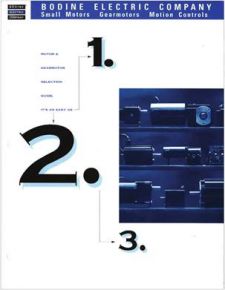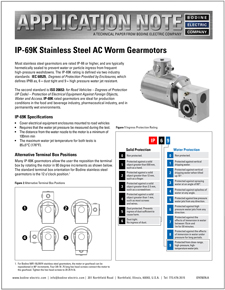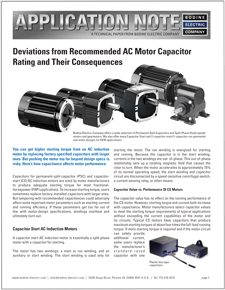
Bodine Gearmotor 1-2-3 Selection Guide
This selection guide was designed to help you specify the best motor, gearmotor and control solution for your application. By considering three key design criteria, you can quickly select a drive system that should meet your application needs: (1) Determine the required speed and torque. (2) Select the appropriate motor type. (3) Select gear reducer, if needed. Bodine literature no. 07481011B.
Download PDF
DC - 07470077.A Filtering Tips For Bodine type WPM and UPM Controls in Industrial Machines
This PDF provides guidelines for installing Bodine type WPM and UPM controls in equipment or applications that are sensitive to Electromagnetic Interference (EMI). Bodine literature no. 07470077A. Updated 06/2022.
Download PDF
IP-69K Stainless Steel AC Worm Gearmotors
Most stainless steel gearmotors are rated IP-66 or higher, and are typically hermetically sealed to prevent water or particle ingress. In this application note, we review how IP-69K is defined and what it means for your application: read about IEC 60529, Degrees of Protection Provided by Enclosures, which defines IP-69 as, 6 = dust tight and 9 = high pressure water jet resistant, and the “K” from ISO 20653. We also provide installation tips for these IP-69K gearmotors. Bodine literature no. 07400078A.
Download PDF
Features and Benefits of Hypoid Gearmotors
Right-angle gearmotors with hypoid gearsets have several advantages when compared with standard worm-and-pinon right-angle gearmotors. Hypoid gearmotors are more efficient, produce less heat, provide higher torque, and are usually smaller than equivalent gearmotors with worm-and-pinion reducers.
Download PDF
Wiring a 34B/SR-WX Gearmotor in Non-Hazardous Locations
How-To Instructions
This application note explains the steps to properly wire our standard 34B/SR-WX, 12/24VDC gearmotors for remote operation in a non-hazardous location. For remote operation of these products in a Class I, Division 2, Groups A, B, C, or D hazardous environment, please review your local safety rules and regulations.
Download PDF
Deviations from Recommended AC Motor Capacitor Rating and Their Consequences
You can get higher starting torque from an AC induction motor by replacing factory specified capacitors with larger ones. But pushing the motor too far beyond design specs is risky. Learn how capacitance affects motor performance. Bodine literature no. 07400079A.
Download PDF
Typical Operating Conditions for AC Gearmotors and Motors
Engineering Tips
This tech note explains how operating an AC induction gearmotor or motor beyond the ratings shown on the product nameplate can affect its performance. Bodine literature no. 074700765A
Download PDF
Safe Operating Area: AC Inverter Duty Gearmotors
We define SOA Torque as the maximum torque at which the motor still operates within Class F thermal limits, or as the maximum torque of a gearmotor when it is gear-limited. Continuous duty operation must be limited to the area below the SOA or gear-limited torque curves. The SOA speed of our inverter-duty non-synchronous AC 3-phase motors and gearmotors is...
Download PDF
Introduction to Planetary Gearmotors
Engineering Tips
Planetary gearheads are typically comprised of a sun gear, a ring gear, and a planet carrier assembly with three to five planet gears per stage. Planetary gear trains are popular in applications where more torque is required from a smaller gearmotor package.
Download PDF
What is a Synchronous AC Motor?
Engineering Tips
The difference between the speed of the rotating magnetic field of an induction motor (which is always synchronous) and the speed of the rotor is known as "slip". When the rotor design enables it to "lock into step" with the field, the slip is reduced to...
Download PDF















